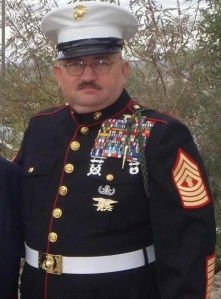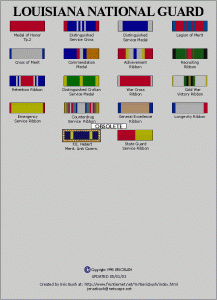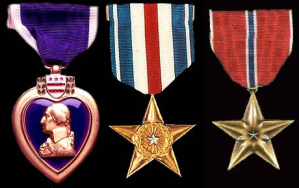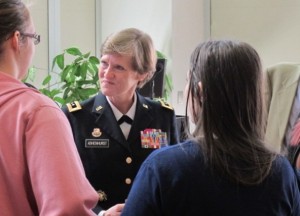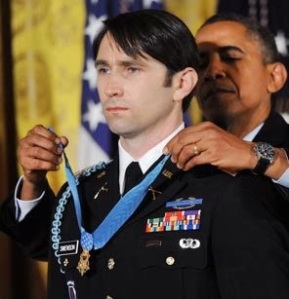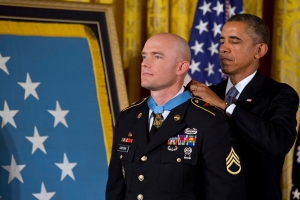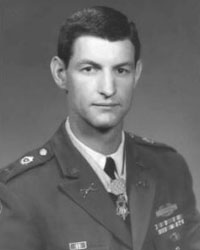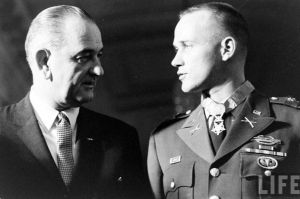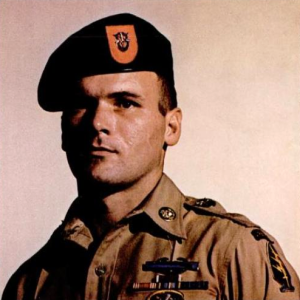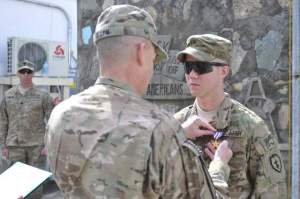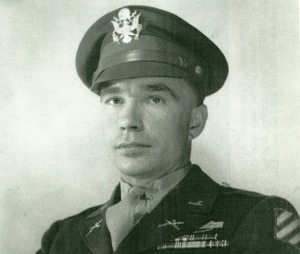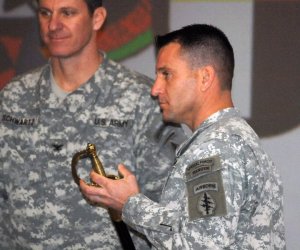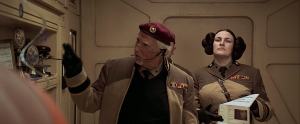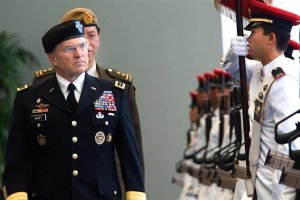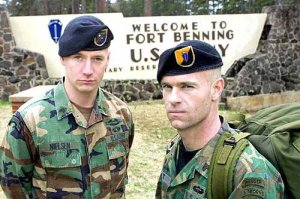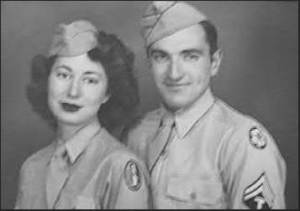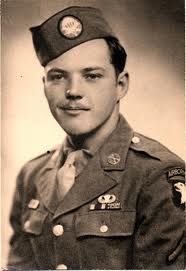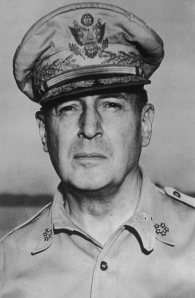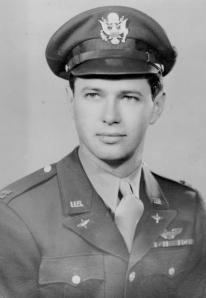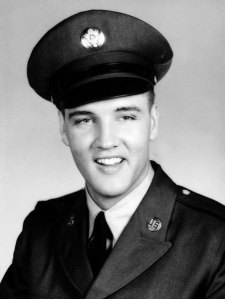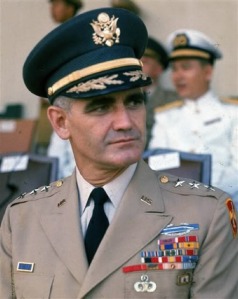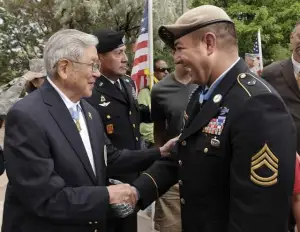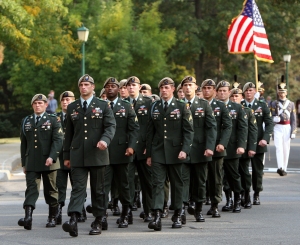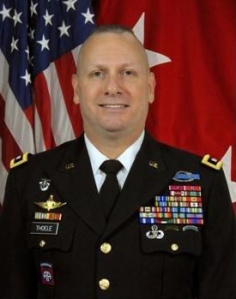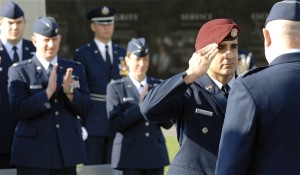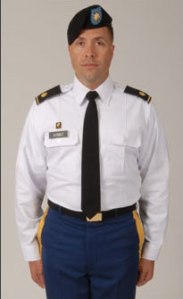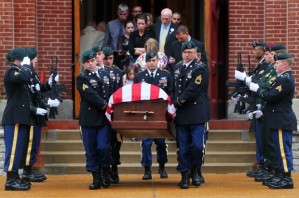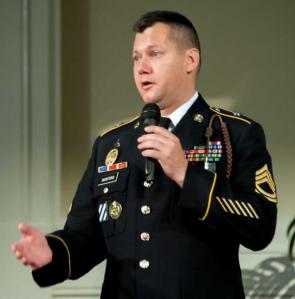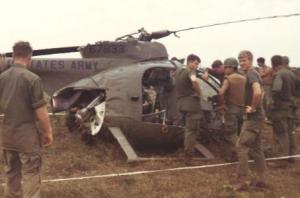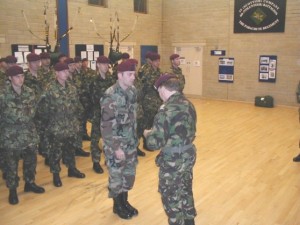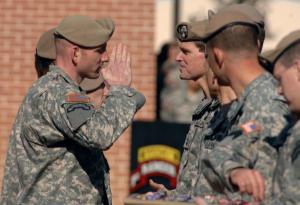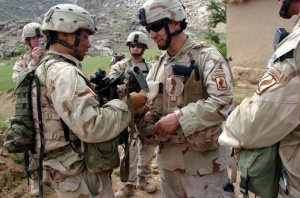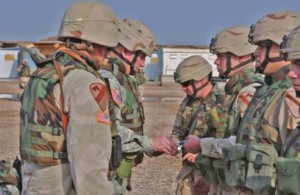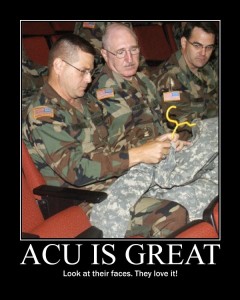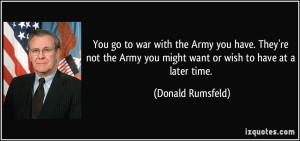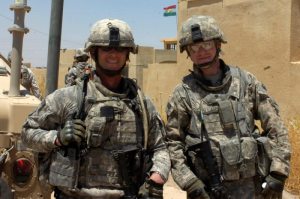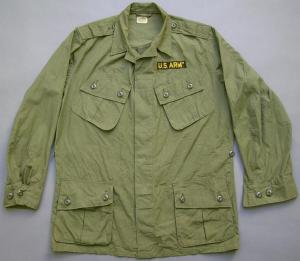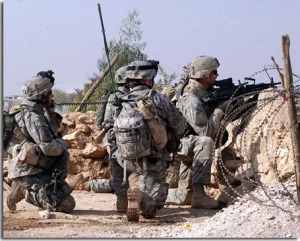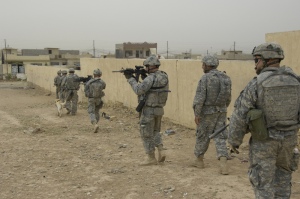we’re back
Foreign badges on US uniforms
Considering how cluttered the appearance of the new ASU uniform is, along with the the current push that all future operations should be conducted with our allies and never unilaterally as well as a regional alignment policy instituted for non-Special Forces units such as 1st Infantry Division with Africa or whether it’s our air support for NATO operations in Libya against Muammar Gaddafi or training Iraqis in Jordan because of the ISIS successes in Anbar province or traditional peacekeeping duties like Kosovo, Sinai and Haiti or our presence in an allied host country like South Korea, it’s interesting that we haven’t been allowed to wear foreign badges on our field uniforms since 1980. Although the army allows wear of foreign badges on dress uniforms.
Like I said
http://www.gallup.com/fvideo.aspx?i=2969sYDlmZhI6W47pBTGtAaa
Gallup poll conducated last month confirms what I’ve been writing about
“Americans Say U.S. Army Is Most Important; Marines Most Prestigious”
May 23, 2014
Less is more when it comes to uniforms
I’ll open this entry by warning any would be imposters who might want to use the information I am providing to portray themselves as special operations veterans. You do a huge disservice to those few service members who are and were members of SOF who have endured many hardships, not just in combat but personal, including a huge divorce rate, missing their children’s birthdays, going without food or sleep and not getting weekends off because they are training or serving in a hostile environment. There are many hardships Rangers, Seals, etc. endure and it’s not just bullets, mines or rockets. When you’re partying on New Year’s eve, they are humping a 85lb ruck over 20 miles at a 13 minute mile per hour pace while mosquitoes are all over the place after less than 4 hours of sleep navigating in the dark of the early morning over difficult terrain like mountains, jungles or the freezing artic. But often the challenges in their lives are personal, like time spent with their kids and takes a toll on them and their families. Respect that, respect their service and their dedication to their brothers in arms and our nation and rather than attempt to obtain accolades for something you aren’t, show your support by contributing to the Wounded Warriors program or volunteering at the USO. Not everyone can be a special operator but everyone can give something to their community, the military (such as care packages or letters) and the nation. The military is just one avenue to contribute to your country. All service is admirable, from picking up garbage on the highway to being a cook in the US Navy.
Also, it is not my intent to divulge individual operator’s identifies. All of the photos I am using are available from open public sources, so public affairs and the US military have approved the release of these pictures for public viewing.
Generally speaking the air force awards it’s airmen more frequently than the other branches and the Marines award medals the least often. Combat arms tends to award medals less frequently than combat support and officers by far receive medals and awards more often than enlisted soldiers. Also, over the last 10 years, decorations and medals have not been awarded based on the criteria of the medal and are more often awarded based on rank than for action or merit.
http://www.johntreed.com/militarymedals.html
When I was a private back in the 1980s, I lamented only having 1 ribbon and over time became resentful for not receiving awards for performance above and beyond that of my peers while others, often those in the rear and not out in the field, received an award or access to a school. I had left the military on a few occasions over the last 20 years, re-enlisting years later with huge breaks in service, only to find some things had changed and some things never change. Last year my entire company, including our 1st Sergeant laughed out loud, during a battalion formation as the battalion XO read the citation for an award to a staff member from another company who was given an achievement medal for 1 week of good driving.
I will be retiring in 5 years and I no longer pine or wish to have a uniform covered in ribbons.
But one thing I’ve noticed in the last 10 years is a preponderance of soldiers whose uniforms look like fruit salad on overkill but who’s awards don’t actually represent very much beyond service. It reminds me of a scene from the British sitcom Red Dwarf “what are those medals for?” “this medal is for 2 years long service, this is for 4 years long service, this is for 8 years long service”.
One thing poseurs and wannabees have right, is the recognition received for the wear of decorations for valor, such as the Medal of Honor or silver star.
In the Army National Guard, there are “state” awards not recognized by the federal government for wear on active duty dress uniforms. I myself have one which I’ve never worn.
The purple heart is awarded for wounds or injuries received as a result of the enemy that require a doctor’s care. A silver star is always awarded for valor. A bronze star can be awarded for valor or for merit. If it is for valor a bronze V is attached to the ribbon in the middle. The same for the commendation medal which also features a V on the ribbon if it is awarded for valor
But some individuals wear every possible ribbon, badge or medal they are entitled to.
For example these female officers have more ribbons than soldiers awarded the MoH for actions in Afghanistan.
Compare the number of ribbons in the photos above to these decorated veterans who’ve served in combat.

MOH recipient Col Howard has 12 ribbons 2 of which are a distinguished service cross and a silver star
The first thing veterans and service members who have served in combat arms will look for on a dress uniform is whether an individual has any decorations for valor. All other ribbons or medals are meaningless and therefore a big rack of ribbons is pointless in their eyes. So few service members are awarded medals for heroism that the government maintains a database for the public at http://valor.defense.gov/
In order of “high to low” to put it in civilian vernacular, the Medal of Honor is at the top while the Distinguished service medal which is a little known medal is the next award ranking below the MoH followed by the silver star, then the bronze star with V, then the air medal or commendation medals with V device if for valor. The Navy, Marines and Air Force have achievement medals for valor unlike the Army.
Even in World War 2 combat veterans would often only wear their “combat decorations” and nothing else.
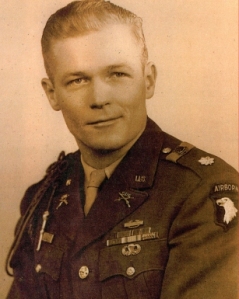
Maj Winters did not wear all ribbons and medals he was entitled to wear but note the DSC and BSM are worn

The most decorated soldier in Army history only wearing 7 ribbons including the Medal of Honor in this photo
http://www.dailymail.co.uk/news/article-2579429/Judge-Decorated-soldier-wont-Medal-Honor.html

The army service ribbon aka the “gay pride” ribbon is in the bottom middle on PFC Manning’s uniform in this photo
So although I have not been awarded any decorations for valor, I wear fewer ribbons than I am entitled to wear (such as the Army training ribbon aka “gay pride” ribbon) and I no longer care about being awarded medals for non-combat related accomplishments such as the achievement medal or the meritorious service medal.
In the same way that WW2 Marines made the anchor and globe a respected and well known symbol combined with the slogan “every Marine is a rifleman” the idea of one symbol being all that matters on a uniform also occurs in the Army SOF units. The truth of the matter, is the USMC is not an elite force in the true definition of the term but it is a well trained organization that has promoted itself over the last 100 years, along with a record of accomplishments in our nation’s wars, so that it’s reputation has become a household world not just in the US but all over the world. For example, in Britain Marines are high esteemed.
In SOF (known to the civilian public as Navy Seals, Rangers, Air Force pararescue and “green berets”) one expression you’ll hear in the Army from operators on the teams is “just the tabs”. Meaning they will not and do not wear jumpmaster wings, air assault badges or any, as the expression I once heard at Fort Lewis “bolo badges” on the front of their uniforms. May’be Halo badges or possibly combat diver badge being the rare exception
The tabs are seen as a “gut check” and bolo badges like jump wings, air assault badge, etc. aren’t seen as especially challenging, especially these days as standards have lowered since the 1980s.
One guy in my SF company, who was longtabbed (special forces) with participation in Desert Storm, Panama’s Just Cause and OEF (Iraq) who had just returned from Pathfinder school remarked “some captain, had his family show up to the graduation ceremony, if pathfinder is the highlight of your career, you’re a loser”.
So you’ll see alot of SF guys who only have Special Forces (long tab) and Ranger (short tab) on their uniforms.
One friend of mine from 5th Bn, 19th SF group, impressed me by rarely wearing anything on his uniform including the tabs and the “combat patch” when training non-SF units. He served on 2 tours in Iraq, made E-7 but was unable to complete the combat diver course. I was sad to hear of his departure from the military last year.
There have been exceptions in the past, such as the famed WW2 tank commander, General Patton
But for the most part, the thing most quiet professionals will look for on a dress uniform is decorations for valor, possibly campaign stars or arrowhead on campaign ribbons and special operations “combat patches” on the class A or as they now are “metal identification badges” on the ASU. For the field uniform (BDU, ACU, Marpat, multicam, etc) it’s the tabs with the exception being the Halo badge or the mustard stain denoting a combat jump(s) and for the the Marine Corps the diver badge and USMC jump wings.
So may’be it’s time the US Army cuts back on covering the uniform in every possible way and puts more emphasis on the person wearing the uniform than trying to look like some 21st century Hollywood action hero written by people who haven’t served a day in the military let alone in combat.
The latest shitty change to Army uniforms is the Army Service Uniform aka ASU
When the economy finally improves and the Army has difficulty recruiting new soldiers, will it turn to more uniform changes to lure prospective recruits? How bad will things get? Will the US Army eventually dress it’s generals up like South American dictators or North Korean generals next? Or is it’s plan to fill the Army with female soldiers (note the word female is going to be banned from use with the Army after the year 2014) in a hope to offset any future trouble finding young men willing to volunteer after the economy gets better?
In my opinion the disintegration of the Army dress uniform began in 2001 with the change to the black beret for all soldiers.
Personally, I’m a fan of the green beret as it was the WW2 movies about the Airborne Divisions jumping behind enemy lines into Normandy and Arnhem and the exploits of the “Green Berets” in Vietnam that attracted me to join the US Army, since my family had all been in the US Marine Corps or the US Navy.
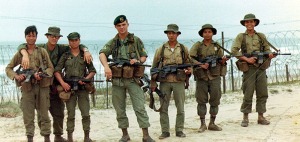
Green berets train, advise and work with foreign soldiers and civilians in guerilla and counter guerilla warfare
It wasn’t so long ago, Special Forces soldiers were mocked for wearing a girl’s hat as most of the Army brass felt berets were too European for American soldiers to wear.
Ironically, anyone who’s served in an SF unit knows the green beret is rarely worn and mainly for formal occasions or change of command ceremonies. Most Special Forces NCOs and officers wear a patrol cap or “ball” cap, even in garrison and occasionally wear civilian clothes, even on post.
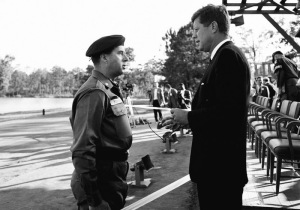
The Green Beret was unauthorized for wear by the US Army until President Kennedy ordered it against the brass’s recommendations
While the fame of the ‘Green Berets’ heroic accomplishments in guerilla warfare in the jungles of Vietnam might have left it’s mark on the public, Special Forces never quite fit into the regular Army’s vision of big tank battles against Soviet forces invading Europe until recently during the war against terrorism, so the Army’s elite, going back to World War 2, has always been the Army Rangers and it was none other than the black beret the Rangers have used since the Vietnam era that began the musical chairs of uniform changes for the Army during the end of the Clinton era until today.
First we had the hairbrained idea from non-other than General Shinseki, appointed by President Clinton, about switching Army headgear to black berets because he said “all soldiers are elite” and the armor “tankers” wore the black beret before the Rangers back during World War 2 (neglecting to mention it was British tankers that wore the black beret not American armored personnel)
All of this ironic given Gen. Shinseki had completed the Ranger course himself but never served in a Ranger Battalion or Regiment.

Shinseki on the right wearing the woodland patrol cap that was standard headgear for the army before the black beret decision
http://www.cnn.com/2011/US/06/13/army.beret/
Army backtracks on black berets after more than a decade of debate
By Larry Shaughnessy, CNN Pentagon Producer
June 14, 2011 12:41 p.m.
The Army’s black beret is being replaced with the patrol cap
“Sanity has prevailed,” says one soldier
Some soldiers say the beret is hot, hard to adjust and takes two hands to put on
Washington (CNN) — Ten years ago this week, under orders from Gen. Eric Shinseki, then Army Chief of Staff, the black beret became standard gear in the U.S. Army. It was the start of a pitched battle within the Army that would soon find itself fighting two hot wars.
Once again, General Shinseki, now retired is back in the news.
From World War 1 to Vietnam soldiers wore the “garrison cap” which was folded into the belt when not being worn.
Even General Eisenhower wore the garrison cap with and without his “Ike” jacket.
Because of the heat, most soldiers in the Pacific theater wore tan uniforms and those in the European theater wore green.
The other option was the service hat also known as the “wheel” or “bus drivers” hat that some soldiers found too cumbersome to carry inside buildings.
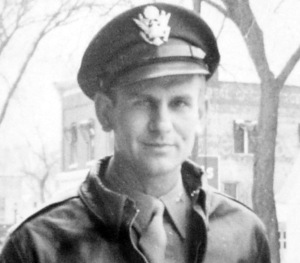
The AAF or Army Air Force of WW 2 before the USAF became it’s own service branch allowed leather jackets to be worn by aircrew and pilots
The service cap or the garrison cap were worn until the black beret was directed for wear by General Shinseki in 2000.
During the difficult recruiting times of the late 1990s when the economy was good and few were enlisting, the larger sized Army was competing with the smaller sized Marine Corps for the same recruits and the Marines were doing a better job marketing, recruiting and kept their recruitment numbers above 100% while the Army hovered around 95-99% of it’s quotas until the economy went bad in 2008.
General Shinseki wanted to boost the flagging morale of the army with a new hat – the beret, arguing all soldiers are elite, so everyone in the Army should wear a black beret like the Army Rangers wore but the Army Rangers opted to switch from the black beret to a tan beret to distinguish themselves from the regular soldiers in the Army, rather than conform to General Shinseki’s idea.
The tan beret the Army rangers have adopted after 2000 looks awful when worn with the new ASU
On the green class A uniform the Ranger and Special Forces tabs, which denote that soldier has successfully completed the Ranger or Special Forces courses, are sewn on the left sleeve.
An airborne tab merely means a soldier is assigned to a unit that is on “jump” status and parachutes from planes or reflects a airborne heritage going back to World War 2 like the 101st Airborne division which hasn’t been on jump status since Vietnam but the Army wanted to retain the unit’s history.
(The 101st Pathfinders was the only unit in the division that remained on jump status until this year)
The Special Forces and Ranger tabs cannot be worn on the ASU so they have been replaced by metal badges worn on the pocket which looks incredibly stupid. In my opinion it’s not worth wearing the metal ranger and special forces badges at all on the ASU. It presents a cluttered appearance. Less is more when it comes to looking sharp in a suit.
The new ASU looks like shit and it’s an embarrassment to the Army, like the black beret issued to all soldiers 10 years ago or the ACU camouflage uniform issued for wear in Iraq and Afghanistan and the woodland pattern body armor issued for wear in Iraq with the DCU during the invasion of Iraq.
Previously only Special Forces (green berets) or Rangers or Paratroopers were authorized to wear berets with the green Class A dress uniform and they wore “jump boots” as well. Unlike the ASU the “dress blues” required a blue service cap for all soldiers regardless of unit or rank.
(US Air Force pararescue and combat controllers as well as security airman “MPs” also wear berets)
The class A “greens” will no longer be authorized for wear after 2014 and replaced by the blue ASU which looks awful with the maroon beret of the paratroopers.

A white short sleeve shirt is worn for hot climates or temperatures instead of the blue coat for the ASU
During the Vietnam era until 1985 a tan long sleeve shirt was worn underneath the Class A green uniform or a short sleeve shirt for hot climate locations like Hawaii or South Vietnam.
The Green beret looks especially bad when worn with the new ASU.
During the Vietnam era into the 1980s the uniform worn hadn’t changed much since World War 2
The Army claimed it was returning to it’s civil war roots by choosing a blue uniform but the civil war uniform featured stripes that wrapped around the entire sleeve or covered most of the lower portion of the sleeve whereas the new ASU uses the Class A service stripes and overseas bars which are much smaller.
Along with changes to the camouflage uniform the Army couldn’t keep it’s hands off the dress uniform and money that could have been spent on more important things has been spent keeping up with the Joneses otherwise known as the US Marine Corps.
The United States Marine Corps who don’t wear any berets and haven’t changed their uniforms since before World War 2, beyond the female hat controversy, have their own dress blues, which are very popular.
The Marine’s have often featured their dress blues in their commercials, recruiting posters and during parades to inspire young men to enlist into the Marine Corps and their dress blues have had a lasting influence on the public’s perception of the “tough” “lean and mean” men that make up the Marine Corps as well as the confidence, strength and masculinity that supposed to come from having served in the USMC.

United States Marine Corps dress blues, note the service stripes below the rank at the bottom of the sleeves
The Army merely switched the former Class A service uniform to the color blue, moved around some patches and badges then ditched the green Class As and dumped the previously well respected “dress blues” reducing Army dress uniforms from 2 to 1, like it’s ridiculous idea that the Army only needed 1 camouflage uniform – the ACU claiming it was a universal pattern that would work in any environment. Meanwhile the other services, especially the US Navy retain several dress uniforms for wear.
Each service stripe on Navy and Marine uniforms represents 4 years of service in the military.
The army service stripes on the “dress blues”, only worn by enlisted personnel with 3 or more years of service, have been replaced by the small “ticks” on the new ASU in the green class A style.

Note the service stripes on the bottom of the left and right sleeves of the old “dress blues” which were worn for more formal occasions than the green Class A uniform
While the other services retained their original large sized service stripes for their enlisted soldiers on their dress blues for Marines and whites or black or tan for sailors (olive for Aviation personnel in the Navy)
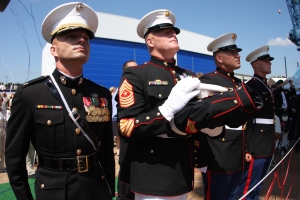
The Marine Corps has established a continuity of tradition while remaining relevant to today’s wars and their uniforms display that

Navy sailors with service stripes. The Navy and Marine corps wear 1 stripe for every 4 years of service.
Overseas bars are a tradition going back to World War 1 and represent time served overseas during wartime.
Originally located on the left sleeve during World War 1 and 2, they were relocated to the right sleeve, except on the “dress blues”. They are also on the right sleeve of the ASU.
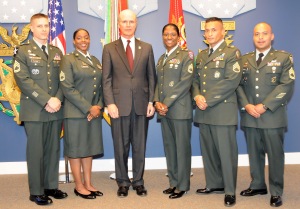
Note the right sleeve of the SSG on the left of this photo. The stripes on his right sleeve are overseas bars
In the past the Marine Corps was substantially smaller than the Army, during World War 2 into the cold war but by the time of the Iraq invasion that was no longer true.
Nevertheless, the Marines have maintained that their high standards, smaller force structure and their idea that “every Marine is a rifleman 1st” including cooks and clerks have instilled in the public at large the belief that the Marine Corps is an elite fighting force. In fact Marine infantryman receive only 2 more weeks training than a standard Army infantryman, primarily for familiarity with waterborne operations, swimming and extended marksmanship training. But their promotion of the individual Marine has impacted the public’s perception of who the “few and the proud are” while the Army kept it’s focus on equipment, like tanks, helicopters, artillery, new trucks and high tech radios as well as mottos like “Be all you can be” “Army of One” and “Army Strong” which has diminished the reputation of the individual soldier, especially compared to the World War Two era.
http://www.wired.com/2012/08/army-new-vehicle/

Audie Murphy the most decorated soldier in Army history was barely 5’6 tall. He received a battlefield commission in WW2
The US Army has promoted that it’s edge against our enemies is not the individual soldier but it’s investment in high technology. Even back during Vietnam era, the Army maintained that the Viet Cong guerillas and the North Vietnamese Army were no match for airmobile warfare that the new helicopter represented. This same concept permeates the US Air Force with it’s F-22 stealth fighter and the US Navy with it’s DDG 1000 destroyer, the Navy Seals which make up 1% of the USN notwithstanding.
The Marines still have a dress “green” uniform for wear but after 2014 the Army will no longer use it’s dress green uniform. One thing I’ve noticed is a fit soldier in a tailored uniform looks much better than an overweight soldier in an unaltered uniform.
The previous army dress blues were limited to wear for funerals, weddings, balls or special occasions while the greens were worn for less ceremonial occasions that required a more formal appearance than the “camouflage” uniforms worn in the field.

Class A “greens” vs new ASU, it’s replacement, these soldiers are wearing the cavalry hat associated with helicopter or armored and cavalry units
The new uniform has taken on a crowded appearance with the new metal badge on the lower right pocket replacing the cloth “combat patch” previously worn on the right shoulder as well as the drill sergeant badge right next to it. It’s one step from third world dictator look.

Note the 101st Airborne Division patch on the right shoulder of this Medal of Honor recipient meeting President Richard Nixon
The “combat patch” officially known as a the former wartime service insignia has been relocated to the right chest below the right pocket and is a metal badge instead of a cloth patch as worn on the green Class A uniform like it was during World War 2, Korea, Vietnam, Greneda, Panama and Desert Storm.
The “combat patch” is also worn on the field aka “camouflage” uniform and has been a tradition going back to World War 1. None of the other services wear it, except Air Force personnel assigned to Army units.
In the past I wanted to wear everything I was awarded, earned or issued but an experience in the summer of 2000 at Fort Drum New York at the 10th Mountain Division Lightfighter school changed my mind, after I noticed the First Sergeant who ran the school did not wear his ranger tab, his jump wings or any of his authorized badges or patches and merely “ranger rolled” his patrol cap and walked with military bearing everywhere. That was when I began to think, the clothes don’t make the man.
Additionally, I’m so offended by the new changes to the Army dress uniform that I have chosen not to wear the new combat badge, as Army regulations do not require the wear of badges, ribbons or patches on dress or field uniforms only the correct placement if a service member chooses to wear them and even on my ACU I often wear nothing but what’s required; US flag, unit of assignment patch, name and branch tapes.
Additionally, I can proudly boast that since 1999, I have only worn the black beret once for 5 minutes during a uniform inspection.

In the early days of Vietnam a color combat patch was worn instead of the black and green patch adopted in the 1970s to go with the field uniform
Unfortunately the class A uniform switched to a lime green shirt worn underneath the coat in 1986 but it looked better than the ASU otherwise and the dress blues look better than the ASU.
10 years later I’m vindicated
During the invasion of Iraq the army had soldiers running around with a big green bulls eye because the body armor was all in the woodland pattern in preparation for war against the Soviet Union that collapsed over 10 years before in 1992, while the army spent money on unneeded programs and a new black beret for everyone.
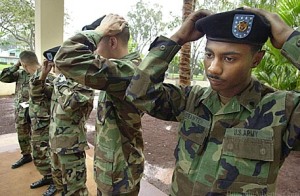
The saying “issued not earned” came around the time the black beret was mandated for all soldiers to wear after basic training was completed
The DCU without woodland “green” body armor pictured below.
DCU stands for Desert Camoflage Uniform.
The DCU was good enough, considering the lack of widespread use of NVGs by our enemies from 2001-2011 and the money that went to all the uniform changes in the last 15 years could have been spent on more training or better equipment or body armor in the DCU pattern to match our uniforms.
Then there was the ACU, that was supposed to prove the Army was past the cold war era and in the cutting edge of 21st century technology which included communications equipment that didn’t work and helicopters and artillery that was too expensive to field.
Back during Desert Storm, at the end of the cold war, we had the “chocolate chip uniforms” for wear in the desert and it didn’t take fancy computer generated uniforms or changes in headgear to win decisively.
Then there was the flag added to the uniform, first below the “patch” officially known as the shoulder sleeve insignia for former wartime service then above it.
All the crap I got from fellow soldiers, members on paratrooper.net and my commanders in 2004 for pointing out that the ACU was inappropriate for use in Iraq and Afghanistan and now the army is replacing the uniform the brass claimed worked well in all environments all over the world and negated the need for different types of uniforms for artic, desert terrain or jungles.

The ACU color and pattern was originally invented for urban environments under the presumption that all 21st century wars would take place in cities and it was quickly picked after the Marine Corps embarrassed the army by picking a digital pattern before the Army had finished it’s testing and trials for the new camouflage uniform of the hi-tech 21st century army. We have yet to fight in a modern city like New York, London or Tokyo. May’be when the zombies come, the ACU will return.
The funniest part was how the Army altered the ACU with “improvements” like changing the pants pockets from Velcro to buttons (like the old BDUs) and now even the sleeves are buttoned, not Velcro, like the old BDUs – lessons learned in Vietnam about quiet, simple methods to get maps, MREs and anything you might need out of uniforms in the dark while the enemy was near.
The ACU was worn from 2004 – 2009 in Afghanistan
The ACU was worn from 2004 – 2011 in Iraq
The Army considered Iraq an urban environment because of the built up spaces but it was hardly a modern city that would feature grey buildings the ACU could blend in with.
The ACU became an issue after several soldiers in Afghanistan complained to the Army times and their senators in 2009 and years after Special Forces personnel had been wearing multicam.
This news article below explains the latest changes from the ACU to a new pattern.
http://www.armytimes.com/article/20140523/NEWS04/305230076/Army-selects-new-camo-pattern
The Army has decided on a new camo to replace the unpopular Universal Camouflage Pattern on your ACUs— and the selection is very similar to MultiCam.
Its color palette of muted greens, light beige and dark brown resembles MultiCam, the pattern used by soldiers deploying to Afghanistan. However, Scorpion W2 uses fewer beige and brown patches and none of the vertical twig and branch elements later added for MultiCam.
The new pattern will serve as the service’s primary camo pattern, but Army uniform leaders have said they envision a “family” of patterns with a dark jungle-woodland variant and a lighter pattern for desert environs. The main camouflage pattern would be worn in garrison, and the others would go to deploying troops.
Cramer said while MultiCam and Scorpion may look similar, he believes MultiCam is better-performing.
The Scorpion W2, according to a source, was among the 22 patterns considered in 2010 when the Army began shopping for new combat uniforms. The Army narrowed that down to four finalists (Scorpion was not among them) and late last year it looked like leaders were nearing a deal with Crye to adopt MultiCam.
But then talks broke down over cost, according to Crye.
The Army’s options are somewhat limited. Congress, in the 2014 Defense Authorization Act, directed the Defense Department to rein in uniform spending and adopt a camouflage utility uniform or family of uniforms across all services. It has forced the Army to take a closer look at existing camouflage patterns — particularly those of its sister services, mainly the woodland and desert versions of the Navy and Marine Corps combat uniforms.
Col. Robert Mortlock, the program manager for Soldier Protection and Individual Equipment, told Army Times at the time that the service examined camo beyond 50 meters and found that, while colors are important, the actual pattern is “not that relevant.”
Army Taps Scorpion to Replace UCP
http://kitup.military.com/
by Matthew Cox on May 23, 2014
The U.S. Army is going to dust off its old Scorpion pattern as a replacement for its much criticized Universal Camouflage Pattern.
I ran a story about the selection this morning on Military.com. I have been told that Sgt. Major of the Army Raymond Chandler III is quietly telling all of the senior sergeant majors around the Army that the service’s new camouflage will be Scorpion — a pattern similar to MuliCam that was developed for the Objective Force Warrior program in 2002.
The Army has been considering replacing UCP with Crye Precision’s MultiCam — a pattern that has demonstrated consistent performance in multiple tests and was selected in 2010 for soldiers to wear in Afghanistan.
But Army officials balked at MultiCam’s price tag. They didn’t want to pay for “printing fees” the company receives on MultiCam — a small figure that amounts to about one percent of the 20-percent price hike uniform companies want to charge the Army for MultiCam, according to Caleb Crye, the owner of CP.
Army officials even tried to buy the rights to MultiCam. Crye told the Army it would cost $25 million if the service wanted to buy the rights to the pattern, which would essentially put Crye Precision out of business, he said.
So with that option off the table, the Army is now going to use Scorpion since the service has owned it for the past 12 years. The pattern is very similar to MultiCam because Crye developed it for the OFW program.
MuliCam’s appearance is slightly different for trademark purposes.
















